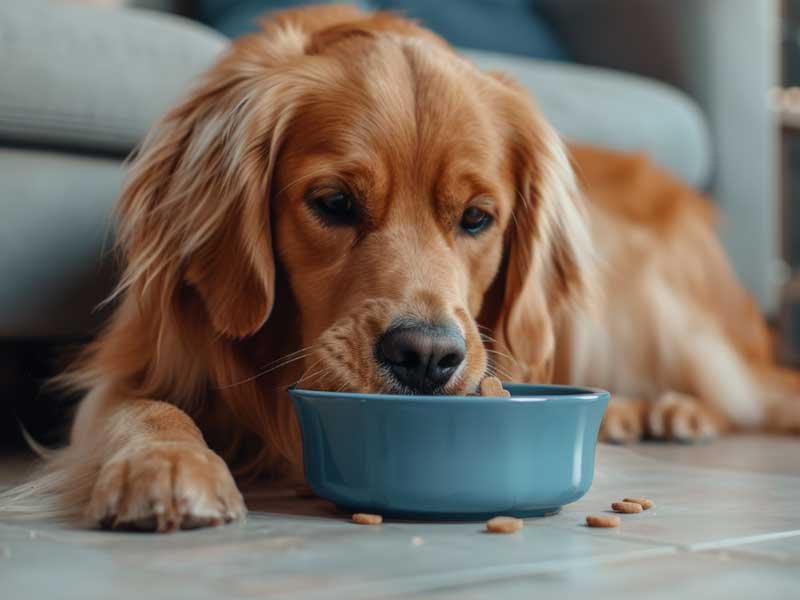Determining the Right Portion Size for Your Dog
How do you determine the right portion size for your dog? This is a common question many pet owners have. Your dog’s health and well-being are closely linked to the amount of food you provide. Getting it just right can make a real difference in their quality of life.
Understanding Your Dog’s Nutritional Needs
Every dog is unique, and factors such as age, breed, size, and activity level significantly impact their nutritional needs. Knowing your dog’s specifics helps you understand the right portion size.
Age Considerations
Puppies, adult dogs, and senior dogs have different dietary needs. Puppies require more calories for growth, while senior dogs might need fewer calories but more nutrients to maintain their health.
- Puppies: Usually need 2-3 meals a day; they require more calories per pound for their rapid growth.
- Adults: Typically eat twice a day, and the calorie intake will depend on the dog’s weight and activity level.
- Seniors: Often require less food due to lower activity levels and a slower metabolism.

Breed and Size
The breed of your dog can affect how much they should eat as well. Smaller breeds may require higher calorie density food compared to larger breeds.
- Small Breeds: Generally require around 40 calories per pound.
- Medium Breeds: Average about 30 calories per pound.
- Large Breeds: Usually require about 20 calories per pound.
Activity Level
Your dog’s lifestyle is a significant determinant of how much food they need.
- Active dogs: Working dogs or those that run regularly will require more calories.
- Less active dogs: If your dog is more of a couch potato, you may want to adjust downwards.
Reading Dog Food Labels
Dog food packages have nutritional guidelines which are a good starting point for determining how much to feed your dog. Understanding these labels can help you identify the right amount to feed.
Ingredient List
The first step is to take a look at the ingredient list. Quality food will have meat as the first ingredient. Avoid foods with fillers such as corn or by-products that don’t offer much nutritional value.
Feeding Guidelines
Most dog food labels provide feeding guidelines. These guidelines suggest how much food to feed based on your dog’s weight. While these are useful, remember they are just guidelines.
Guaranteed Analysis
This section shows the percentage of protein, fat, fiber, and moisture in the food. Choose a balance that matches your dog’s needs, as different life stages may require variations in these components.
Using Body Condition Score (BCS)
Another effective method to assess whether you’re feeding your dog the right amount is to use the Body Condition Score (BCS). It offers a visual and physical way to evaluate your dog’s body composition.
Understanding BCS
The BCS scale typically ranges from 1 to 9, with:
- 1-3: Underweight
- 4-5: Ideal weight
- 6-9: Overweight
You can determine your dog’s score by assessing their ribs, waist, and abdominal tuck.
How to Perform a BCS Check
- Ribs: You should be able to feel your dog’s ribs with light pressure. If you can’t feel them easily, they may be overweight.
- Waist: Look at your dog from above. There should be a noticeable waist between the ribs and hips.
- Abdomen: From the side, your dog’s abdomen should tuck upwards toward the hind legs.
Adjusting Portion Sizes Based on Observation
Once you have an idea of your dog’s nutritional needs, it’s time to fine-tune their portion sizes. You may need to reassess the amount as your dog ages or as their activity level changes.
Monitoring Weight
The most reliable way to know if you’re feeding the right amount is by keeping an eye on your dog’s weight. If your dog is gaining weight, reduce the food intake. If they’re losing weight, increase it gradually.
Behavior and Energy Levels
Observe your dog’s behavior and energy levels. A dog that is highly active and playful at mealtime is likely receiving the right amount. Conversely, lethargy might indicate overfeeding or underfeeding.
Treat Adjustments
Don’t forget to factor in treats! Treats should comprise only a small percentage of your dog’s daily caloric intake, often no more than 10%. Adjusting their main meal portions can help accommodate treats.

Special Needs Considerations
Some dogs may have special dietary needs due to health concerns. Conditions such as allergies, diabetes, or obesity require specific dietary considerations.
Allergies
If your dog has food allergies, it’s essential to choose a diet that doesn’t exacerbate these issues. This often involves working with your vet to find a limited-ingredient diet.
Obesity
If your dog is overweight, it’s crucial to lower their caloric intake. Aim to reduce the amount gradually rather than making drastic changes. Consulting with your vet can provide tailored advice.
Health Issues
Older dogs or dogs with specific health issues may benefit from specialized diets. This might include lower-protein or low-sodium options depending on their health needs.
Working with Your Veterinarian
Your veterinarian is a vital resource when determining your dog’s portion size. They can provide guidance based on your dog’s specific needs and overall health.
Regular Check-Ups
Regular vet visits allow for ongoing assessments of your dog’s weight and health. These sessions can lead to adjustments in diet and portion sizes that may be necessary as your dog ages or changes.
Dietary Recommendations
Bring any questions or concerns regarding diet to your vet. They can offer recommendations tailored to your dog’s health profile, lifestyle, and preferences.
Conclusion
Determining the right portion size for your dog is crucial for maintaining their health and well-being. By considering factors like age, breed, activity level, and weight, you can make informed decisions about your dog’s nutrition. Regular monitoring and adjustments based on observations and vet guidance will ensure that your canine companion stays happy and healthy for many years to come.
Taking the time to understand your dog’s unique needs and adjusting accordingly can lead to a long and fulfilling life together!





